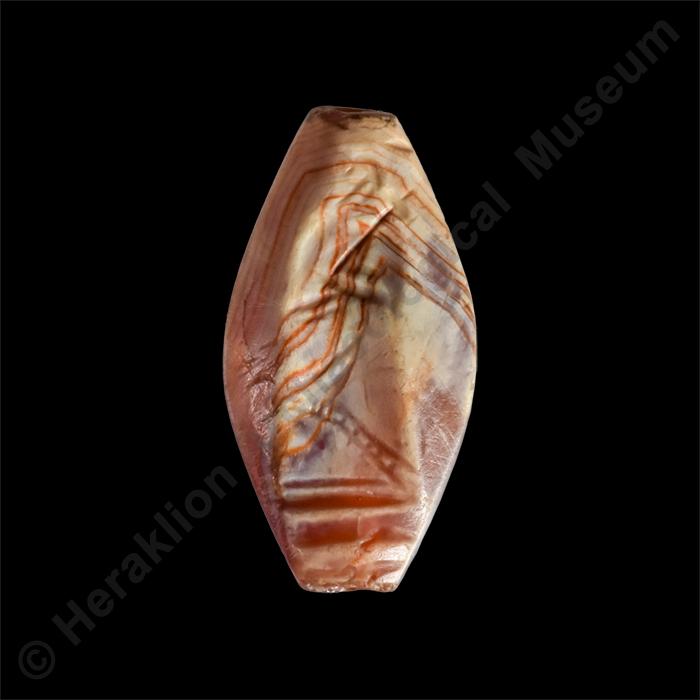Sealstone with priest carrying a ceremonial mace
Σ-Κ1456
Stone (sard with white and pink veining)
Intact
Length: 22 cm.
Malia
Palace, Quartier Δ, House Δβ
Late Bronze Age, Neopalatial period. Late Minoan ΙΑ period:
1550-1500 BC:
Gallery:
VIIICase:
77Exhibition thematic unit:
Late Bronze Age - Neopalatial period (1700-1450 BC). Minoan religion. Palace cultCult scenes
Description
Amygdaloid sealstone with a male priestly figure walking left. He is wearing a long, floor-length garment with diagonal bands and holding a ceremonial mace in his left hand, elbow bent. The man is bearded, indicating that he is an adult of advanced age. On his head is a flat hat. The wide, floor-length robe with characteristic diagonal bands, believed to be of Syrian origin, is first seen in Minoan seal-carving in the Late Minoan I period. In the East, particularly in Syria, it is attested from the 3rd millennium BC and is usually associated with deities, kings, priests and high-ranking officials. The mace also often represents a symbol of authority in Eastern and Egyptian iconography. In this case, however, it is a well-known Minoan ritual emblem, as many similar maces have been found in Minoan palace shrines, peak sanctuaries and tombs of officials. Many scholars consider that this prestigious male figure is the king himself, displaying his power with the appropriate emblems of authority.Bibliography:
P. Demargne, "Un prêtre oriental sur une gemme crétoise du MRI", Bulletin de correspondance héllénique 70 (1946), 148-53. M. Platonos-Manti, "Τελετουργικές σφύρες και ρόπαλα στο μινωικό κόσμο", Αρχαιολογική Εφημερίδα 1981, 81. Corpus der minoischen und mykenischen Siegel II3, 147. N. Marinatos, Minoan Religion. Ritual, Image and Symbol, Columbia 1993, 129-30, fig. 88e ; Minoan Kingship and the Solar Goddess, Illinois 2010, 19-21. E. Davis, "Art and Politics in the Aegean: The Missing Ruler", in P. Rehak (ed.), The Role of the Ruler in the Prehistoric Aegean. Proceedings of a Panel Discussion Presented at the Annual Meeting of the Archaeological Institute of America, New Orleans, Louisiana, 28 December 1992, Aegaeum 11, Liège 1995, 15, pl. VIh. R.B. Koehl, "The Nature of Minoan Kingship", op. cit., 29, pl. XIIg. Ch. Boulotis, "From Mythical Minos to the Search for Cretan Kingship" in M. Andreadaki-Vlazaki, G. Rethemiotakis and N. Dimopoulou-Rethemiotaki (ed.), From the Land of the Labyrinth: Minoan Crete, 3000–1100 B.C. In collaboration with Alexander S. Onassis Public Benefit Foundation (USA), Hellenic Ministry of Culture and Archaeological Museums of Crete, New York 2008, Vol. 2 (Essays), 50-51.Author:
S. M.Photographs' metadata
